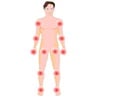Providing biologic medications to people with rheumatoid arthritis can reduce the risk of premature death among such patients, researchers said.

Biologic agents such as anti-tumor necrosis factor drugs (commonly called anti-TNF) are prescribed to control inflammation and prevent joint damage caused by RA. Biologics are also effective at reducing pain and improving physical function. Researchers from the Arthritis Research Centre of Canada, University of British Columbia, evaluated if the benefits of reducing inflammation lead to a lowered risk of premature death in people with rheumatoid arthritis.
Researchers reviewed patient data from the Canadian Ministry of Health. The study included all reported RA cases that received care between January 1996 and March 2006. Cases were followed until March 2010. All health care services used - including medications, hospitalizations and lab tests from January 1990 - were evaluated.
Patients who used a biologic agent during follow-up were placed in one group. Each patient in this biologic group was then matched to a patient from a control group who never used a biologic agent, but was treated with at least three disease-modifying antirheumatic drugs, such as methotrexate (Rheumatrex®, Trexall®), leflunomide (Arava®), hydroxychloroquine (Plaquenil®), sulfasalazine (Azulfidine®) or gold, and had changed DMARD therapy within the last six months. Additional match criteria included age, sex, calendar year of study inclusion and markers of RA disease severity identified in administrative data.
To reduce study bias, researchers took into consideration differences in disease severity, and other factors that may influence the risk of premature death, between the two groups. Researchers evaluated the risk of premature death associated with biologic treatment measured daily from the time of starting biologic until death or until the end of follow-up. Exposure was defined as therapy use from the beginning of treatment and up to three months after therapy was discontinued.
The study evaluated 4,312 total participants, of which 2,156 were biologic users and 2,156 were matched controls. The participants'' mean age was 56 years-old and 74.7 percent of participants were female. The researchers observed 573 deaths of which 326 were in the control group and 247 in the biologic users group. The study revealed that exposure to biologics was associated with a 25 percent reduction in risk of premature death compared to no biologic use. Study limitations include the fact that the treatment studied was not randomly assigned, therefore there may have some selection bias that makes people who received biologic treatment different from those who did not; and the results may also have been influenced by factors that the researchers were not able to be measure using administrative data.
Advertisement
Patients should talk to their rheumatologists to determine their best course of treatment.
Advertisement
The American College of Rheumatology is an international professional medical society that represents more than 9,000 rheumatologists and rheumatology health professionals around the world. Its mission is to advance rheumatology. The ACR/ARHP Annual Meeting is the premier meeting in rheumatology. For more information about the meeting, visit www.acrannualmeeting.org or join the conversation on Twitter by using the official hashtag: #ACR2012.
Learn more about living well with rheumatic disease as well as rheumatologists and the role they play in health care. Also, discover the ACR''s Simple Tasks campaign, which highlights the severity of rheumatic diseases and the importance of early and appropriate referral to a rheumatologist.
Editor''s Notes: Dr. Diane Lacaille, MD, FRCPC, MHSC, will present this research during the ACR Annual Meeting at the Walter E. Washington Convention Center at 3:00 PM on Monday, November 12 in Hall E. Dr. Lacaille will be available for media questions and briefing on at 8:30 AM on Monday, November 12 in the on-site press conference room, Room 203 A-B.
Presentation Number: 1642
Biologics and Mortality Risk in Rheumatoid Arthritis - Results of a Population Based Study
Diane Lacaille (Arthritis Research Centre of Canada, University of British Columbia)
Michal Abrahamowicz (McGill University, Montreal, QC)
Eric C. Sayre (Arthritis Research Centre of Canada, Vancouver, BC)
John Esdaile (Arthritis Research Centre of Canada, University of British Columbia, Vancouver, BC)
Background/Purpose: Biologic agents, due to their effect on disease activity, may reduce the risk of premature mortality in rheumatoid arthritis (RA). We evaluated the association between exposure to biologics and risk of mortality in RA, using a population-based RA cohort with administrative health data.
Methods: Using administrative billing data from the Ministry of Health, we assembled a population-based cohort including all RA cases in the province who received care for RA between 01/1996 and 03/2006, using previously published RA criteria, with follow-up until 03/2010. Administrative data was obtained on all medications since 01/1996; MD visits, hospitalizations, and tests since 01/1990. For this study we identified all RA cases who used a biologic agent (anti-TNF, rituximab, anakinra or abatacept) during follow-up. Each biologic user was matched with one RA control who never used a biologic but used at least 3 DMARDs (to mimic coverage requirements) and with a recent (within 6 mos) change in DMARD. Controls were also matched on age, sex, calendar year of inclusion and closest propensity score, using a greedy matching technique. Matched controls were given the date of initiation of first biologic of the user they were matched to. A propensity score (PS) was calculated at time of initiation using markers of RA severity, as well as co-morbidities increasing risk of death. Despite selecting controls with the closest PS, matching was imperfect; therefore PS quintiles were added to the final multivariable model. Cox proportional hazard model (PHM) was used to estimate risk of death associated with biologic exposure, evaluated as a time dependent variable representing current or recent use of anti-TNF, where cases were considered exposed for up to 3 months after discontinuation. Time analyzed was from date of initiation to death or end of follow-up. PHM analysis was also adjusted for age, sex, RA duration, Charlson co-morbidity score, PS quintiles and the variables included in the PS model that were not balanced. Sensitivity analyses were carried out to test the robustness of results.
Results: Our sample includes 2156 biologic users and 2156 matched controls (mean (SD) age: 56.3(14.6), 74.7% females). We observed 573 deaths (326 in controls; 247 in biologic users). Exposure to biologics was associated with a reduced risk of death (aHR (95%CI): 0.25 (0.18; 0.36), p < 0.0001). A sensitivity analysis not requiring matched controls to have used 3 prior DMARDs or a recent change in DMARD yielded almost identical results (aHR (95%CI): 0.26 (0.18; 0.36), p < 0.0001). Another sensitivity analysis, without use of PS, but where the PS variables were allowed to enter the PHM and controls were only required prior use of one DMARD, yielded similar results (aHR (95%CI): 0.31 (0.22; 0.45), p < 0.0001). Limitations of our study are those inherent to observational study, including possible effect of residual or unmeasured confounding, and selection bias from non-random allocation of treatment.
Conclusion: In a population-based cohort, exposure to biologics was associated with a significant reduction in mortality. Given the increased mortality risk of RA, this has important implications for health policy makers, health care providers and people with arthritis.
Disclosure: Diane Lacaille, None; Michal Abrahamowicz, None; Eric C. Sayre, None; J. Esdaile, None.
Source-Newswise















